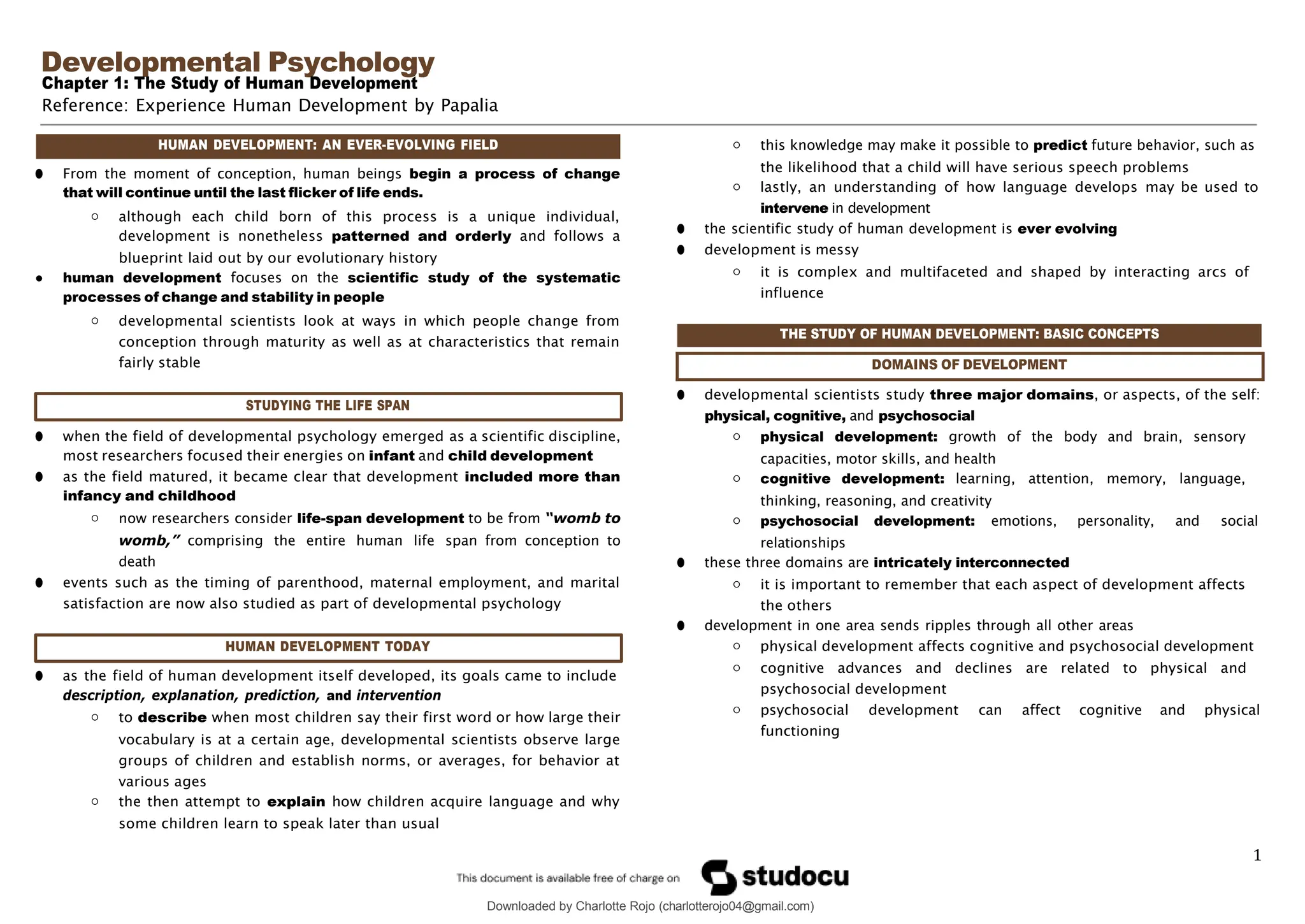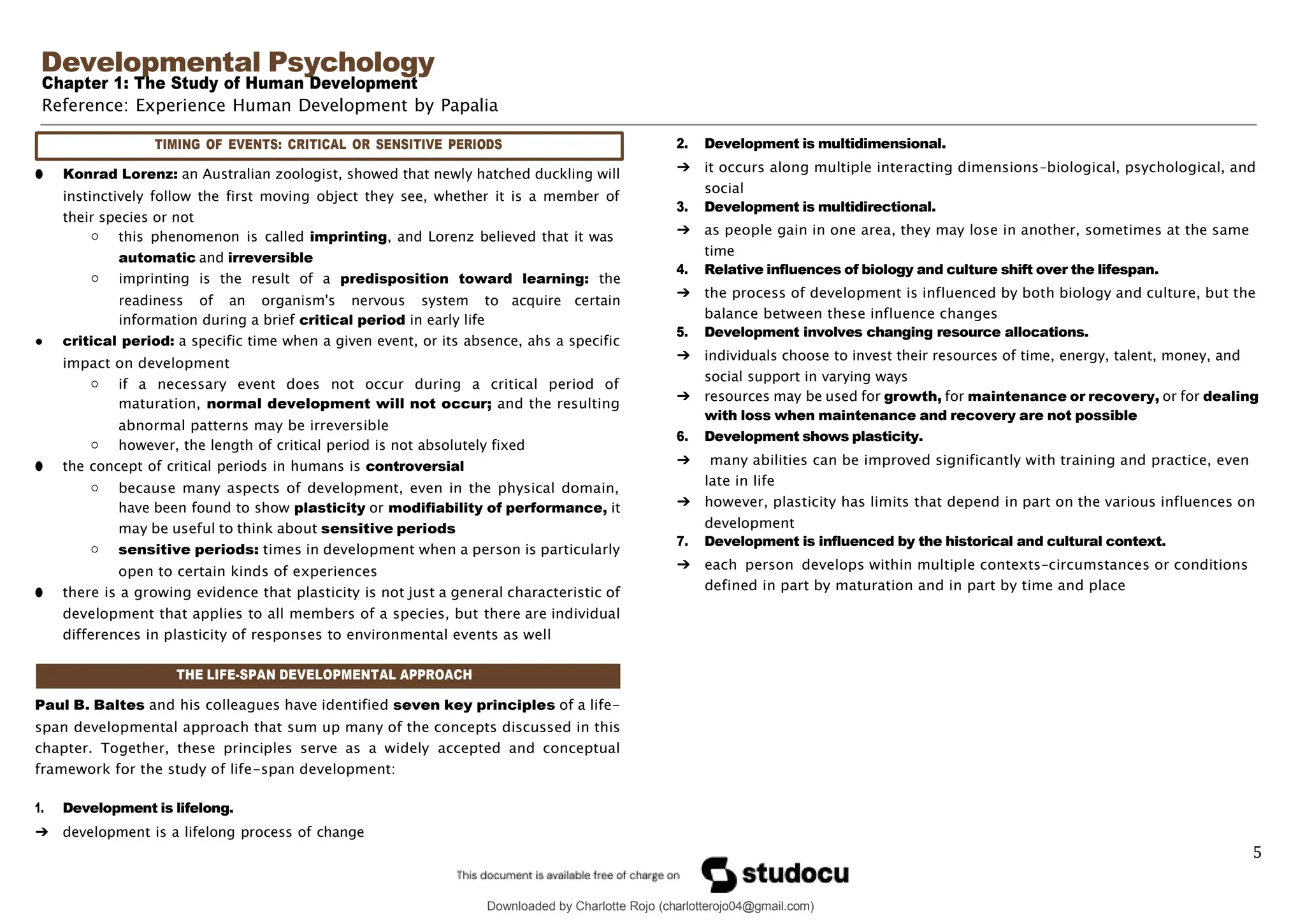The document discusses key concepts in developmental psychology. It covers:
1) The field studies physical, cognitive, and psychosocial development from conception to death across various contexts.
2) Development is influenced by heredity, environment, maturation, and sensitive periods when one is open to certain experiences.
3) Baltes' seven principles of lifespan development frame it as lifelong, multidimensional, multidirectional, and influenced by both biology and culture over one's lifespan.




![Developmental Psychology
Chapter 1: The Study of Human Development
Reference: Experience Human Development by Papalia
Downloaded by Charlotte Rojo (charlotterojo04@gmail.com)
NORMATIVE AND NONNORMATIVE INFLUENCES
○ all of the behavior and attitudes that are learned, shared, and
transmitted among members of a social group
● culture is constantly changing, often through contact with other cultures
● ethnic group: consists of people united by a distinctive culture, ancestry,
religion, language, or natural origin, all of which contribute to a sense of shared
identity and shared attitudes, beliefs, and values
● ethnic and cultural patterns affect development by their influence on the
following:
○ composition of a household,
○ its economic and social resources,
○ the way its members act toward one another,
○ foods they eat,
○ games children play, and
○ the way family members think and perceive the world
● it is important to remember that wide diversity exists within broad ethnic
groups
○ given this diversity within groups, a term such as black or Hispanic can
be an ethnic gloss
○ ethnic gloss: an overgeneralization that obscures or blurs such
variations
● the term race, historically and popularly viewed as an identifiable biological
category, is more accurately defined as a social construct
○ there is no scientific consensus on its definition, and it is impossible to
measure reliably
○ race as a social category remains a factor in research because it
makes a difference in “how individuals are treated, where they live,
their employment opportunities, the quality of their health care, and
whether [they] can fully participate” in their society
● categories of culture, race, and ethnicity are fluid
○ it is continuously shaped and defined by social and political forces
● at one time developmentalists paid little attention to the historical context–the
time in which people live
● today, the historical context is an important part of the study of development
● to understand similarities and differences in development, we need to look at
two types of normative influences: biological or environmental events many or
most people in a society in similar ways and events that touch only certain
individuals
● normative age-graded influences: highly similar for people in a particular age
group
○ the timing of biological events is fairly predictable within a normal
range
● normal history-graded influences: significant events that shape the behavior
and attitudes of a historical generation
○ historical generation refers to a group of people who experience the
event at a formative time in their lives
○ it is not the same as an age cohort: a group of people born at about the
same time
○ a historical generation may contain more than one cohort, but cohorts
are as part of a historical generation only if they experience major,
shaping historical events at a formative point in their lives
● nonnormative influences: unusual events that have a major impact on
individual lives because they disturb the expected sequence of the life cycle
○ either typical events that happen at an atypical time of life (such as
the death of a parent when a child is young) or atypical events (such
as surviving a plane crash)
○ people sometimes help create their own nonnormative life events
● the three types of influences–normative age-graded, normative
history-graded, and nonnormative–contribute to the complexity of human
development as well as to the challenges people experience in trying to build
their lives
4
THE HISTORICAL CONTEXT](https://image.slidesharecdn.com/developmental-psychology-chapter-1-by-papalia-240213093549-709dbfa4/75/developmental-psychology-chapter-1-by-papalia-docx-5-2048.jpg)
